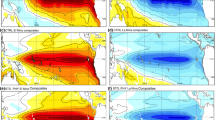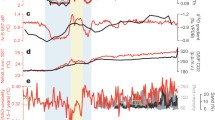Abstract
This study analysed the changes in El Niño Southern Oscillation (ENSO) dynamics as they are simulated in 25 models of the CMIP5 simulations for the RCP8.5 scenario relative to the historical control simulation. The ENSO linear recharge oscillator (ReOsc) framework is used to focus on changes in the growth rate of eastern equatorial Pacific sea surface temperature (T) and mean equatorial Pacific thermocline depth (h) anomalies, the coupling between the two and the noise forcing driving the ENSO variability. We further focused on the feedbacks controlling the growth rate of T, namely the Bjerknes wind to sea surface temperature (SST) feedback, the atmospheric net heat flux and the residual oceanic feedback. We find significant changes in nearly all of these important elements of the ENSO dynamics, despite the fact that the ensemble shows very little changes in the overall ENSO variability. The growth rate of T weakens resulting from a combination of increased negative atmospheric net heat flux feedbacks, increased positive Bjerknes wind-SST feedback and increased residual oceanic feedbacks. Further notable changes are, an increase in the growth rate of h and a stronger coupling of T to h. Sensitivity analysis of the ReOsc model can explain why these strong dynamical changes lead to effectively no changes in the overall ENSO variability, but are likely to affect the predictability of ENSO.










Similar content being viewed by others
References
Bayr T, Dommenget D, Martin T, Power SB (2014) The eastward shift of the Walker circulation in response to global warming and its relationship to ENSO variability. Clim Dyn 43:2747–2763. https://doi.org/10.1007/s00382-014-2091-y
Bayr T, Latif M, Dommenget D, Wengel C, Harlaß J, Park W (2018) Mean-state dependence of ENSO atmospheric feedbacks in climate models. Clim. Dyn. 50:3171–3194. https://doi.org/10.1007/s00382-017-3799-2
Bellenger H, Guilyardi E, Leloup J, Lengaigne M, Vialard J (2014) ENSO representation in climate models: from CMIP3 to CMIP5. Clim Dyn 42:1999–2018. https://doi.org/10.1007/s00382-013-1783-z
Boucharel J, Dewitte B, du Penhoat Y, Garel B, Yeh S-W, Kug J-S (2011) ENSO nonlinearity in a warming climate. Clim Dyn 37:2045–2065
Burgers G, Jin FF, van Oldenborgh GJ (2005) The simplest ENSO recharge oscillator. Geophys Res Lett 32:1–4. https://doi.org/10.1029/2005GL022951
Cai W, Wang G, Santoso A, McPhaden MJ, Wu L, Jin FF, Timmermann A, Collins M, Vecchi G, Lengaigne M, England MH, Dommenget D, Takahashi K, Guilyardi E (2015a) Increased frequency of extreme La Niña events under greenhouse warming. Nat Clim Change 5(2):132–137
Cai W et al (2015b) ENSO and greenhouse warming. Nat Clim Change 5:849–859. https://doi.org/10.1038/nclimate2743
Capotondi A, Sardeshmukh PD (2017) Is El Niño really changing? Geophys Res Lett 44:8548–8556. https://doi.org/10.1002/2017GL074515
Chen L, Li T, Yu Y (2015) Causes of strengthening and weakening of ENSO amplitude under global warming in four CMIP5 models. J Clim 28:3250–3274
Chen C, Cane MA, Wittenberg AT, Chen D (2017) ENSO in the CMIP5 simulations: life cycles, diversity, and responses to climate change. J Clim 30:775–801. https://doi.org/10.1175/jcli-d-15-0901.1
Collins M et al (2010) The impact of global warming on the tropical Pacific Ocean and El Niño. Nat Geosci 3:391–397. https://doi.org/10.1038/ngeo868
Dinezio PN, Kirtman BP, Clement AC, Lee SK, Vecchi GA, Wittenberg A (2012) Mean climate controls on the simulated response of ENSO to increasing greenhouse gases. J Clim 25:7399–7420. https://doi.org/10.1175/JCLI-D-11-00494.1
England MH et al (2014) Recent intensification of wind-driven circulation in the Pacific and the ongoing warming hiatus. Nat Clim Change 4:222–227. https://doi.org/10.1038/nclimate2106
Frauen C, Dommenget D (2010) El Niño and la Niña amplitude asymmetry caused by atmospheric feedbacks. Geophys Res Lett 37:1–6. https://doi.org/10.1029/2010GL044444
Guan C, McPhaden MJ (2016) Ocean processes affecting the twenty-first-century shift in ENSO SST variability. J Clim 29:6861–6879. https://doi.org/10.1175/JCLI-D-15-0870.1
Jansen MF, Dommenget D, Keenlyside N (2009) Tropical atmosphere–ocean interactions in a conceptual framework. J Clim 22:550–567. https://doi.org/10.1175/2008JCLI2243.1
Jin F-F (1997) An equatorial ocean recharge paradigm for ENSO. Part II: a stripped-down coupled model. J Atmos Sci 54:830–847. https://doi.org/10.1175/1520-0469(1997)054%3c0830:aeorpf%3e2.0.co;2
Jin FF, Kim ST, Bejarano L (2006) A coupled-stability index for ENSO. Geophys Res Lett 33:L23708
Jin EK et al (2008) Current status of ENSO prediction skill in coupled ocean–atmosphere models. Clim Dyn 31:647–664. https://doi.org/10.1007/s00382-008-0397-3
Kessler WS (1990) Observations of long Rossby waves in the northern tropical Pacific. J Geophys Res. https://doi.org/10.1029/jc095ic04p05183
Kim ST, Jin FF (2011) An ENSO stability analysis. Part II: results from the twentieth and twenty-first century simulations of the CMIP3 models. Clim Dyn 36:1609
Kim ST, Cai W, Jin FF et al (2014) ENSO stability in coupled climate models and its association with mean state. Clim Dyn 42:3313
Kohyama T, Hartmann DL, Battisti DS (2017) La Niña-like mean-state response to global warming and potential oceanic roles. J Clim 30:4207–4225. https://doi.org/10.1175/JCLI-D-16-0441.1
Lee T, McPhaden MJ (2010) Increasing intensity of El Niño in the central-equatorial Pacific. Geophys Res Lett 37:1–5. https://doi.org/10.1029/2010GL044007
Liu Z, Vavrus S, He F, Wen N, Zhong Y (2005) Rethinking tropical ocean response to global warming: the enhanced equatorial warming. J Clim. https://doi.org/10.1175/jcli3579.1
Lloyd J, Guilyardi E, Weller H (2012) The role of atmosphere feedbacks during ENSO in the CMIP3 models. Part III: the shortwave flux feedback. J Clim 25:4275–4293. https://doi.org/10.1175/JCLI-D-11-00178.1
Lübbecke JF, Mcphaden MJ (2014) Assessing the twenty-first-century shift in enso variability in terms of the bjerknes stability index. J Clim 27:2577–2587. https://doi.org/10.1175/JCLI-D-13-00438.1
Luo Y, Lu J, Liu F, Liu W (2015) Understanding the El Niño-like oceanic response in the tropical Pacific to global warming. Clim Dyn 45:1945–1964. https://doi.org/10.1007/s00382-014-2448-2
Luo Y, Lu J, Liu F, Garuba O (2017) The role of ocean dynamical thermostat in delaying the El Niño-Like response over the equatorial Pacific to climate warming. J Clim 30:2811–2827. https://doi.org/10.1175/jcli-d-16-0454.1
Luo JJ, Wang G, Dommenget D (2018) May common model biases reduce CMIP5’s ability to simulate the recent Pacific La Niña-like cooling? Clim Dyn 50:1335–1351. https://doi.org/10.1007/s00382-017-3688-8
Maher N, Sen Gupta A, England MH (2014) Drivers of decadal hiatus periods in the 20th and 21st centuries. Geophys Res Lett 41:5978–5986
Manabe S, Stouffer RJ, Spelman MJ, Bryan K (1991) Transient responses of a coupled ocean–atmosphere model to gradual changes of atmospheric CO2. Part I. Annual mean response. J Clim 4:785–818
McPhaden MJ (2012) A 21st century shift in the relationship between ENSO SST and warm water volume anomalies. Geophys Res Lett 39:1–5. https://doi.org/10.1029/2012GL051826
McPhaden MJ, Lee T, McClurg D (2011) El Niño and its relationship to changing background conditions in the tropical Pacific Ocean. Geophys Res Lett 38:2–5. https://doi.org/10.1029/2011GL048275
Meyers G (1979) On the annual Rossby wave in the tropical north Pacific ocean. J Phys Oceanogr. https://doi.org/10.1175/1520-0485(1979)009%3c0663:otarwi%3e2.0.co;2
Moss RH et al (2010) The next generation of scenarios for climate change research and assessment. Nature 463:747–756. https://doi.org/10.1038/nature08823
Rhein M, Rintoul SR, Aoki S, Campos E, Chambers D, Feely RA, Gulev S, Johnson GC, Josey SA, Kostianoy A, Mauritzen C, Roemmich D, Talley LD, Wang F (2013) Observations: ocean. In: Stocker TF, Qin D, Plattner G-K, Tignor M, Allen SK, Boschung J, Nauels A, Xia Y, Bex V, Midgley PM (eds) Climate change 2013: the physical science basis. Contribution of working group I to the fifth assessment report of the intergovernmental panel on climate change. Cambridge University Press, Cambridge
Smith NR (1995) An improved system for tropical ocean subsurface temperature analyses. J Atmos Ocean Technol 12(4):850–870. https://doi.org/10.1175/1520-0426(1995)012%3c0850:AISFTO%3e2.0.CO;2
Stevenson S, Fox-Kemper B, Jochum M, Neale R, Deser C, Meehl G (2012) Will there be a significant change to El Niño in the twenty-first century? J Clim. https://doi.org/10.1175/jcli-d-11-00252.1
Taylor KE, Stouffer RJ, Meehl GA (2012) An overview of CMIP5 and the experiment design. Bull Am Meteorol Soc 93:485–498. https://doi.org/10.1175/BAMS-D-11-00094.1
Van Oldenborgh GJ, Philip S, Collins M (2005) El Niño in a changing climate: a multi-model study. Ocean Sci 1:81–95
Vecchi GA, Soden BJ (2007) Global warming and the weakening of the tropical circulation. J Clim 20:4316–4340. https://doi.org/10.1175/JCLI4258.1
Vecchi GA, Soden BJ, Wittenberg AT, Held IM, Leetmaa A, Harrison MJ (2006) Weakening of tropical Pacific atmospheric circulation due to anthropogenic forcing. Nature 1:1. https://doi.org/10.1038/nature04744
Vijayeta A, Dommenget D (2017) An evaluation of ENSO dynamics in CMIP simulations in the framework of the recharge oscillator model. Clim Dyn. https://doi.org/10.1007/s00382-017-3981-6
Wittenberg AT, Rosati A, Delworth TL, Vecchi GA, Zeng F (2014) ENSO modulation: is it decadally predictable? J Clim 27:2667–2681
Yang H, Wang F (2009) Revisiting the thermocline depth in the equatorial Pacific. J Clim 22:3856–3863. https://doi.org/10.1175/2009JCLI2836.1
Yeh SW, Kug JS, Dewitte B, Kwon MH, Kirtman BP, Jin FF (2009) El Nĩo in a changing climate. Nature 461:511–514. https://doi.org/10.1038/nature08316
Yoshimori M, Watanabe M, Shiogama H, Oka A, Abe-Ouchi A, Ohgaito R, Kamae Y (2016) A review of progress towards understanding the transient global mean surface temperature response to radiative perturbation. Prog Earth Planet Sci 3:21
Zhao M, Hendon HH, Alves O, Liu G, Wang G (2016) Weakened Eastern Pacific El Nino predictability in the early twenty-first century. J Clim 29:6805–6822. https://doi.org/10.1175/JCLI-D-15-0876.1
Acknowledgements
The work was supported by the Australian Research Council (ARC) Centre of Excellence in Climate System Science (CE110001028), the ARC Centre of Excellence in Climate Extremes (CE170100023) and the ARC project “Beyond the linear dynamics of the El Niño Southern Oscillation” (DP120101442). The work presented here has a long history going back to 2007 with a number of people contributing to the analysis over time that we like to acknowledge here: Malte Jansen, Claudia Frauen, Simona Trefalt, Chevillard Jeanne and Payan Timothée and Yanshan Yu.
Author information
Authors and Affiliations
Corresponding author
Additional information
Publisher's Note
Springer Nature remains neutral with regard to jurisdictional claims in published maps and institutional affiliations.
Electronic supplementary material
Below is the link to the electronic supplementary material.
Rights and permissions
About this article
Cite this article
Dommenget, D., Vijayeta, A. Simulated future changes in ENSO dynamics in the framework of the linear recharge oscillator model. Clim Dyn 53, 4233–4248 (2019). https://doi.org/10.1007/s00382-019-04780-7
Received:
Accepted:
Published:
Issue Date:
DOI: https://doi.org/10.1007/s00382-019-04780-7




